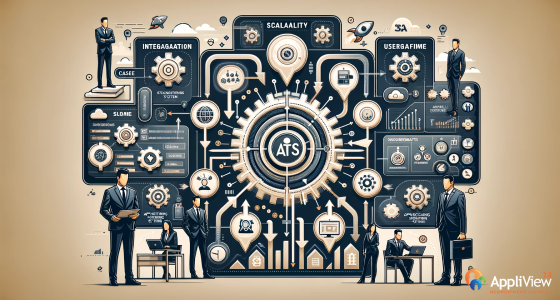The Evolution of Applicant Tracking Systems: From Simple Tracking to Advanced Analytics
March 22, 2024
Applicant Tracking Systems (ATS) have evolved from basic monitoring tools to sophisticated analytics tools, revolutionizing the recruitment process. Initially, ATS focused on optimizing the hiring process through automation. As technology progressed, cloud-based solutions provided recruiters with more flexibility and accessibility. Advanced analytics, based on data-driven recruitment, have become essential for efficient and effective recruitment processes. Modern ATS features include customization options, AI and machine learning capabilities, and mobile optimization. The future of ATS is promising, with predictive analytics emerging as a pivotal trend. Organizations should consider scalability, integration capabilities, and user-friendliness when selecting an ATS.
The Evolution of Applicant Tracking Systems: From Simple Tracking to Advanced Analytics
Delving into the historical roots of Applicant Tracking Systems where the article illuminates the transformative journey of recruitment technology. While the concept of managing job applications through technology isn’t novel, ATS has evolved over decades into an indispensable tool for applicant databases and recruitment. In the pre-ATS era, HR staff faced challenges with manual processes, relying on newspapers and hard-copy applications. The narrative unfolds the revolutionary impact of recruitment software, showcasing the shift from traditional methods to digitized management using technologies like email, Excel files, and online application forms.
In the beginning
The evolution of Applicant Tracking Systems (ATS) has been a crucial factor in the fast-paced world of recruitment, where securing the right talent can transform a company’s success or failure. ATS has experienced a significant evolution since its inception as rudimentary monitoring tools, maturing into sophisticated analytics powerhouses that have revolutionized the way in which organizations approach talent acquisition.
The Initial Phases of ATS

Initially, the primary objective of Applicant monitoring Systems was to optimize the hiring procedure through the automation of candidate monitoring. Although groundbreaking in their era, these systems were comparatively uncomplicated, providing only the most fundamental capabilities to oversee portfolios and optimize communication. Recruiters encountered difficulties in effectively handling substantial quantities of data prior to the widespread adoption of sophisticated functionalities.
Developments in Monitoring Systems
As technology progressed, applicant tracking systems also evolved. The advancement of cloud-based solutions brought about a paradigm shift in the field, affording recruiters enhanced flexibility and accessibility. The implementation of automation brought about a substantial reduction in manual labor, enabling human resources professionals to allocate their efforts towards more strategic facets of the recruitment process. The synergy among various HR functions was further enhanced through integration with more comprehensive HR software.
The Development of Advanced Analytics
There has been a notable shift in attention towards data-driven recruitment in recent years. Contemporary ATS have embraced advanced analytics as their foundation, as it provides insights that transcend mere monitoring. The ability of recruiters to make data-driven decisions has resulted in enhanced employment processes that are both efficient and effective. The adoption of analytics signifies a pivotal moment in recruitment, wherein the objective is no longer merely to locate candidates, but to identify the most suitable ones.
Important Characteristics of Modern ATS
A multitude of contemporary ATS features are designed to facilitate a streamlined and customized recruitment process. Options for customization enable organizations to tailor the system to their specific requirements. The capabilities of AI and machine learning eliminate uncertainty from candidate evaluation, yielding invaluable insights into prospective employees. Mobile optimization accommodates the requirements of a mobile and diverse workforce by ensuring that the recruiting process is streamlined and accessible from any location.
Selecting the Appropriate ATS for an Organization

Choosing the appropriate ATS is critical for organizations seeking to maintain a competitive edge in the talent market. It is important to consider elements such as scalability, integration capabilities, and user-friendliness. Practical case studies exemplify effective implementations, providing valuable insights into the ways in which analogous enterprises have derived advantages from distinct ATS solutions. Merely avoiding prevalent hazards during the selection process is of equal significance in order to guarantee a seamless and triumphant adoption.
Prospects for the Future of Applicant Tracking Systems
At this juncture, the ATS voyage continues. Phenomenal prospects abound in the future, wherein predictive analytics emerges as a pivotal trend. It is anticipated that the integration of ATS with other HR technologies will result in a more comprehensive approach to talent management. Applicant tracking systems are poised to advance alongside technological developments, thereby facilitating the implementation of more refined and streamlined recruitment procedures.
Conclusion
So, here’s the deal – Applicant Tracking Systems (ATS) are like the rockstars of the hiring game. They started as these basic monitors and now, they’re rocking sophisticated analytics like nobody’s business. It’s like tech threw a party in the recruitment world and ATS showed up as the main act. Organizations are relying on these bad boys to build dream teams. And guess what? The party’s not over. There’s more tech magic on the horizon, promising even better efficiency and innovation in the talent acquisition scene. Get ready for the future, folks!